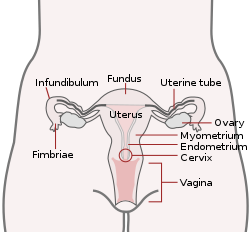ഫലോപ്യൻ കുഴലുകൾ
| ഫാലോപ്യൻ ട്യൂബ് | |
|---|---|
 Uterus and fallopian tubes labelled as uterine tubes | |
| Details | |
| System | പ്രത്യുത്പാദനേന്ദ്രിയ വ്യൂഹം |
| Artery | tubal branches of ovarian artery, tubal branch of uterine artery via mesosalpinx |
| Lymph | ലംബർ ലിംഫ് നോഡുകൾ |
| Identifiers | |
| Latin | Tuba uterina |
| Greek | Salpinx |
| MeSH | D005187 |
| TA | A09.1.02.001 |
| FMA | 18245 |
| Anatomical terminology | |
ഗർഭാശയ ട്യൂബുകൾ, അണ്ഡവാഹിനികൾ[1] അല്ലെങ്കിൽ സാൽപിംഗുകൾ (സിംഗുലർ സാൽപിൻക്സ്) എന്നും അറിയപ്പെടുന്ന ഫാലോപ്യൻ ട്യൂബുകൾ, ഗർഭപാത്രം മുതൽ അണ്ഡാശയത്തിലേക്ക് നീളുന്ന മനുഷ്യ സ്ത്രീയിൽ ജോടിയാക്കിയ ട്യൂബുകളാണ്. ഫാലോപ്യൻ ട്യൂബുകൾ സ്ത്രീകളുടെ പ്രത്യുത്പാദന വ്യവസ്ഥയുടെ ഭാഗമാണ്. മറ്റ് സസ്തനികളിൽ അവയെ അണ്ഡവാഹിനികൾ എന്ന് മാത്രമേ വിളിക്കൂ.[2]
ഓരോ ട്യൂബും പേശീബലമുള്ള പൊള്ളയായ അവയവമാണ്[3] അത് ശരാശരി 10 മുതൽ 14 സെന്റീമീറ്റർ വരെ നീളവും 1 സെന്റീമീറ്റർ ബാഹ്യ വ്യാസവുമുള്ളതാണ്.[4] ഇതിന് നാല് വിവരിച്ച ഭാഗങ്ങളുണ്ട്: ഇൻട്രാമ്യൂറൽ ഭാഗം, ഇസ്ത്മസ്, ആമ്പുള്ള, അനുബന്ധ ഫിംബ്രിയകളുള്ള ഇൻഫുണ്ടിബുലം. ഓരോ ട്യൂബിനും രണ്ട് ഓപ്പണിംഗുകൾ എന്നിവ ഉണ്ട്. ഒരു പ്രോക്സിമൽ ഓപ്പണിംഗ് ഗർഭപാത്രത്തോട് അടുത്ത് തുറക്കുന്നു. കൂടാതെ ഒരു വിദൂര ദ്വാരം ഉദരത്തിലേക്ക് തുറക്കുന്നു. ഫാലോപ്യൻ ട്യൂബുകൾ ട്യൂബുകൾക്ക് ചുറ്റും പൊതിഞ്ഞിരിക്കുന്ന വിശാലമായ ലിഗമെന്റ് മെസെന്ററിയുടെ ഭാഗമായ മെസോസൽപിൻക്സായിലാണ് സ്ഥാപിച്ചിരിക്കുന്നത്. വിശാലമായ ലിഗമെന്റിന്റെ മറ്റൊരു ഭാഗം, മെസോവേറിയം അണ്ഡാശയത്തെ സ്ഥാനത്ത് നിർത്തുന്നു.[5]
ഒരു അണ്ഡകോശം അണ്ഡാശയത്തിൽ നിന്ന് ഫാലോപ്യൻ ട്യൂബിലേക്ക് കൊണ്ടുപോകുന്നു. അവിടെ അത് ട്യൂബിന്റെ ആമ്പുള്ളയിൽ ബീജസങ്കലനം നടത്താം. ഫാലോപ്യൻ ട്യൂബുകൾ സിലിയ എന്ന് വിളിക്കപ്പെടുന്ന രോമസമാനമായ വിപുലീകരണങ്ങളുള്ള സിമ്പിൾ കോളുമ്നാർ എപിത്തീലിയത്തോടുകൂടിയതാണ്. ഇത് പേശി പാളിയിൽ നിന്നുള്ള പെരിസ്റ്റാൽറ്റിക് സങ്കോചങ്ങൾക്കൊപ്പം ബീജസങ്കലനം ചെയ്ത അണ്ഡത്തെ (സൈഗോട്ട്) ട്യൂബിലൂടെ ചലിപ്പിക്കുന്നു. ഗർഭാശയത്തിലേക്കുള്ള അതിന്റെ യാത്രയിൽ സൈഗോട്ട് കോശവിഭജനത്തിന് വിധേയമാകുന്നു. അത് ഇംപ്ലാന്റേഷനുള്ള ഒരു ആദ്യകാല ഭ്രൂണമായി അതിനെ ഒരു ബ്ലാസ്റ്റോസിസ്റ്റാക്കി മാറ്റുന്നു.[6]
വന്ധ്യതയുടെ ഏതാണ്ട് മൂന്നിലൊന്ന് കേസുകളും ഫാലോപ്യൻ ട്യൂബ് പാത്തോളജികൾ മൂലമാണ്. വീക്കം, ട്യൂബൽ തടസ്സങ്ങൾ എന്നിവ ഇതിൽ ഉൾപ്പെടുന്നു. ബീജത്തിന്റെയോ അണ്ഡത്തിന്റെയോ ചലനത്തെ തടസ്സപ്പെടുത്തുന്ന നിരവധി ട്യൂബൽ പാത്തോളജികൾ ട്യൂബിന്റെ സിലിയക്ക് കേടുപാടുകൾ വരുത്തുന്നു.[7]
ഇറ്റാലിയൻ കത്തോലിക്കാ പുരോഹിതനും ശരീരഘടനാശാസ്ത്രജ്ഞനുമായിരുന്ന ഗബ്രിയേൽ ഫാലോപ്പിയോയിൽ നിന്നാണ് ഈ പേര് വന്നത്. മറ്റ് ശരീരഘടനകൾക്കും അദ്ദേഹത്തിന്റെ പേരുണ്ട്.[8]
ഘടന
[തിരുത്തുക]പ്രോക്സിമൽ ട്യൂബൽ ഓപ്പണിംഗ് അല്ലെങ്കിൽ പ്രോക്സിമൽ ഓസ്റ്റിയം എന്നറിയപ്പെടുന്ന ഗർഭാശയ ഹോൺസുകളിലെ ഒരു ദ്വാരത്തിലാണ് ഓരോ ഫാലോപ്യൻ ട്യൂബും ഗർഭപാത്രത്തിൽ നിന്നും പുറപ്പെടുന്നത്.[9] ട്യൂബുകൾക്ക് ശരാശരി 10-14 സെന്റീമീറ്റർ (3.9-5.5 ഇഞ്ച്) [4] നീളമുണ്ട്. അതിൽ ട്യൂബിന്റെ ഇൻട്രാമ്യൂറൽ ഭാഗം ഉൾപ്പെടുന്നു. ട്യൂബുകൾ അണ്ഡാശയത്തിന് സമീപം വരെ നീളുന്നു. അവിടെ അവ വിദൂര ട്യൂബൽ ഓപ്പണിംഗുകളിൽ വയറിലേക്ക് തുറക്കുന്നു. മറ്റ് സസ്തനികളിൽ ഫാലോപ്യൻ ട്യൂബിനെ അണ്ഡവാഹിനി എന്ന് വിളിക്കുന്നു. ഇത് മനുഷ്യനിലെ ഫാലോപ്യൻ ട്യൂബിനെ പരാമർശിക്കാനും ഉപയോഗിക്കാം.[10][11] ട്യൂബുകൾക്ക് ചുറ്റും പൊതിഞ്ഞിരിക്കുന്ന വിശാലമായ ലിഗമെന്റ് മെസെന്ററിയുടെ ഒരു ഭാഗം മെസോസാൽപിൻക്സാണ് ഫാലോപ്യൻ ട്യൂബുകൾ സ്ഥാപിച്ചിരിക്കുന്നത്. വിശാലമായ ലിഗമെന്റിന്റെ മറ്റൊരു ഭാഗം, മെസോവേറിയം അണ്ഡാശയത്തെ സ്ഥാനത്ത് നിർത്തുന്നു.[5]
അധിക ചിത്രങ്ങൾ
[തിരുത്തുക]-
Image showing numbered parts of the fallopian tubes and surrounding structures
-
Female reproductive system numbered parts
-
Image showing the right fallopian tube (here labeled the uterine tube) seen from behind. The uterus, ovaries and right broad ligament are labeled.
-
Cross-section of fallopian tube, stained and viewed under microscope
അവലംബം
[തിരുത്തുക]This article was originally based on an entry from a public domain edition of Gray's Anatomy. As such, some of the information contained within it may be outdated.
- ↑ "Uterine Tube (Fallopian Tube) Anatomy: Overview, Pathophysiological Variants". 14 July 2021. Retrieved 15 September 2022.
- ↑ Zhao, W; Zhu, Q; Yan, M; Li, C; Yuan, J; Qin, G; Zhang, J (February 2015). "Levonorgestrel decreases cilia beat frequency of human fallopian tubes and rat oviducts without changing morphological structure". Clinical and Experimental Pharmacology & Physiology. 42 (2): 171–8. doi:10.1111/1440-1681.12337. PMC 6680194. PMID 25399777.
- ↑ Han, Joan; Sadiq, Nazia M. (2022). "Anatomy, Abdomen and Pelvis, Fallopian Tube". StatPearls. StatPearls Publishing. PMID 31613440. Retrieved 22 September 2022.
- ↑ 4.0 4.1 "Fallopian Tube Disorders: Overview, Salpingitis and Pelvic Inflammatory Disease, Salpingitis Isthmica Nodosa". 15 March 2022. Retrieved 17 September 2022.
- ↑ 5.0 5.1 Craig, Morgan E.; Sudanagunta, Sneha; Billow, Megan (2022). "Anatomy, Abdomen and Pelvis, Broad Ligaments". StatPearls. StatPearls Publishing. PMID 29763118. Retrieved 25 September 2022.
- ↑ Tortora, Gerard J. (2010). Principles of anatomy and physiology (12th ed.). Hoboken, NJ: John Wiley & Sons. p. 1103. ISBN 9780470233474.
- ↑ Briceag I, Costache A, Purcarea VL, Cergan R, Dumitru M, Briceag I, Sajin M, Ispas AT (2015). "Fallopian tubes--literature review of anatomy and etiology in female infertility". J Med Life. 8 (2): 129–31. PMC 4392087. PMID 25866566.
- ↑ Castro PT, Aranda OL, Marchiori E, de Araújo LF, Alves HD, Lopes RT, Werner H, Araujo Júnior E (2020). "Proportional vascularization along the fallopian tubes and ovarian fimbria: assessment by confocal microtomography". Radiol Bras. 53 (3): 161–166. doi:10.1590/0100-3984.2019.0080. PMC 7302899. PMID 32587423.
- ↑ Thurmond, Amy S.; Brandt, Kathleen R.; Gorrill, Marsha J. (March 1999). "Tubal Obstruction after Ligation Reversal Surgery: Results of Catheter Recanalization". Radiology. 210 (3): 747–750. doi:10.1148/radiology.210.3.r99mr10747. PMID 10207477. Archived from the original on 15 April 2013. Retrieved 28 May 2010.
- ↑ Li, Shuai; Winuthayanon, Wipawee (January 2017). "Oviduct: roles in fertilization and early embryo development". The Journal of Endocrinology. 232 (1): R1 – R26. doi:10.1530/JOE-16-0302. PMID 27875265. S2CID 27164540.
- ↑ Harris, Emily A.; Stephens, Kalli K.; Winuthayanon, Wipawee (5 November 2020). "Extracellular Vesicles and the Oviduct Function". International Journal of Molecular Sciences. 21 (21): 8280. doi:10.3390/ijms21218280. PMC 7663821. PMID 33167378.
External links
[തിരുത്തുക]- Histology image: 18501loa – Histology Learning System at Boston University
- Menstrual Cycle - Merck




